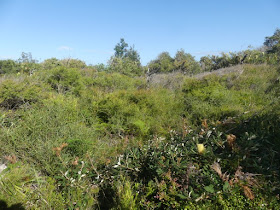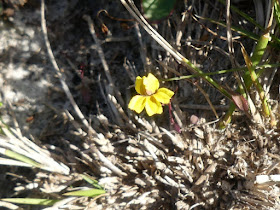Recently we undertook a very pleasant meander through a series of national parks in north-eastern New South Wales (NSW hereafter), not much more than a good day's drive from home, exploring both the wet forest hinterland (including elements of the Gondwana Rainforests of Australia World Heritage Area) and the coastal heaths and forests. In the process we visited some 27 national parks, though most of these were of course fairly fleetingly; we saw it as a reconnaissance for future exploration. In others however we camped for a couple of nights, including Bundjalung, which I'd like to introduce to you today. In forthcoming postings I'll present a couple of the rainforest parks.
 |
| Black Rock Beach, Bundjalung NP, immediately behind the campground of the same name where we stayed. More about the unusually coloured rock formations shortly. |
Today the fairly modestly-sized 21,000 hectare Bundjalung, together with the smaller Broadwater NP to the north and the larger Yuraygir NP to the south, protects a substantial stretch of coastline, well over 100km long (though they are not quite contiguous). If you've driven along the north coast you'll know that much of it comprises a ribbon development of resorts, retirement complexes and giant bananas, so protected coast and the vegetation behind it is a very valuable asset indeed.
Black Rock campground, in the centre of the park, is larger than we feel comfortable with. (Well, to be truthful we'd much rather camp somewhere remote enough so there's no evidence of other people at all. That can often be managed inland in Australia, but is unrealistic and probably elitist near the populous coast, especially in national parks.) Furthermore we made the mistake of being there on a weekend when it was particularly busy. However the campground is well-designed, so that individual sites are tucked into bays in coastal shrubland, giving fairly good privacy from neighbours. There are basic toilets, though probably insufficient for a busy weekend, good information boards and walking tracks leading from the camp. (There is also a campground at Woody Head at the southern end of the park, but seems more like a resort/caravan park, and not somewhere we'd ever choose to stay. It seems to have been tendered out.)
The system for determining which parks in NSW charge entrance fees ($8 per vehicle per day, when applicable) seems utterly random. You do pay at Bundjalung for instance, which offers minimal visitor facilities, but do not at Dorrigo (on the edge of the tableland not far away), which has extensive and excellent facilities. Camping (which at Bundjalung must be pre-booked) is another $24 a night for two people. I don't blame the parks service for this at all - they are constant pressure from government to make parks 'pay for themselves' and there is ever-decreasing government support for them, financially and politically.
OK, back to the park itself! This isn't pretending to be an overall coverage of the park - I can only comment on the areas we saw - but it should give you a reasonable overview. Firstly of course there's the beach, all 37k of it.
Behind the dunes are swathes of lovely heathland, alight with banksia flower when we were there.
 |
| Heathland near the campground. |
 |
| Wallum Banksia B. aemula; wallum is an indigenous word from south-east Queensland, used now to describe the coastal heathland habitat. It is found from just north of Sydney to Fraser Island. |
 |
| Coastal Banksia B. integrifolia is found along the entire east coast; we also saw a form growing to a fair-sized tree in mountain rainforests. |
 |
| Heath-leafed Banksia B. ericifolia grows along much of the NSW coast in sandy soils. |
 |
| Guinea Flower Hibbertia sp., family Dillenaceae. Both this species and the next belong to extensive genera, and I couldn't get them down to a species. |
 |
| Goodenia sp., Family Goodeniaceae. |
Another significant habitat, though less extensive, is that dominated by paperbarks, especially Broad-leaved Paperbark Melaleuca quinquenervia. These forests grow mostly along streamlines and in boggy areas that are regularly inundated.
 |
| Broad-leafed Paperbark along Jerusalem Creek, on a walking track near the camp. |
And in the far south of the park, around Iluka, is a most unexpected habitat indeed, for here, growing on sand, is a rare and precious remnant of littoral (ie coastal) warm temperate rainforest.
 |
| Lianas in the sandy understorey. |
 |
| The canopy trees are primarily Riberry Syzygium luehmannii and Broad-leafed Lilly Pilly Syzygium (formerly Acmena) hemilamprum. |
 |
| Strangler Fig Ficus watkisoniana. |
The busyness of the campground and surrounds certainly mitigated against optimal wildlife viewing, but there was a still a range of animals to be seen in the immediate vicinity of our camp.
 |
| Any east coast campground is likely to have a coterie of big Lace Monitors Varanus varius patrolling in the hope of hand-outs or scavenging opportunities. Black Rock is no exception. |
 |
| One of the camp goannas showing off his/her forked tongue with which they constantly 'taste' the air to assess the environment. For more on these fascinating big lizards, see here. |
A much more benign visitor dropped by very late on our last evening there, as the light was going.
 |
| Swamp Wallaby Wallabia bicolor. |
However our best wildlife viewing came in a small patch of paperbarks along the Jerusalem Creek walking track, not far from camp. It was bustling!
 |
| The scene of the action! This was mid-morning too, well outside the expected peak time of activity. |
Here are some of the animals (mostly birds) which kept our heads spinning.
 |
| A very curious female Mistletoebird Dicaeum hirundicum, one of several in the area. |
 |
| The males were a bit more circumspect; this one is performing his crucial ecological role of distributing mistletoe seeds to other sites on tree branches. |
 |
| Noisy Friarbird Philemon corniculatus, a big (and yes, noisy) honeyeater. The pale scallops on the back tell us that this is a young bird, from last spring's nesting. |
 |
| This honeyeater on the other hand is one we don't see in Canberra. White-throated Honeyeaters Melithreptus albogularis are found north from about here and right across tropical northern Australia. |
 |
| Male Rufous Whistler Pachycephala rufiventris; this one too is a summer breeding migrant to Canberra. |
The one that gave me the most satisfaction out of this lovely little flock was however on the ground. I have never managed to lay lens on a Brown Quail Coturnix ypsilophora before, though I've glimpsed them many times (usually vanishing like little dumpy rockets). This pair however were extraordinarily obliging.
 |
| And when you see them well like these, they really are a very beautifully marked little bird. |
And in between, we were able to enjoy a most beautiful butterfly, one with which I was not familiar.
 |
| Blue Tiger Tirumala hamata; it too was much more accommodating than I've learnt to expect butterflies to be. |
We came back late in the afternoon to indulge ourselves in some more birds and whatever else was about - and of course the entire grove was deserted. Bird-watching can be like life sometimes.
I'll talk about a couple of the other parks we spent time in too, in the not too distant future, but meantime I hope I've persuaded you that Bundjalung is definitely worth a day or so of your time.
NEXT POSTING THURSDAY
(And
remember that you can get a reminder when the next post appears by
putting your email address in the Follow by Email box in the top right
of this screen.
And I'd love to receive your comments - it's easy and you don't need to sign in!)
And I'd love to receive your comments - it's easy and you don't need to sign in!)







Interesting post, as always. Thanks Ian. I visited Iluka some years ago as part of a tour with Go Bush (John Sinclair) which explored the the rain forests of the Mt Warning caldera. Great diversity and huge distances. The Nicholsons were with us to educate us.
ReplyDeleteThanks Kath, and good to hear from you. I don't think I've yet posted on a place in Australia where you hadn't already been! It would have wonderful to travel with the Nicholsons, who unfortunately I never met. It's a lovely part of the world and we're keen to go back with more time and see more of it.
ReplyDelete